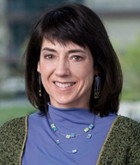

Helen Bronte-Stewart, MD, MSE, Director, Stanford Movement Disorders Center, will participate in a Virtual Deep Brain Stimulation (DBS) Forum on Wednesday, April 22, from 11:00am-12:30pm. In this webinar, you will learn the what, when, why, how, and more of DBS from movement disorder specialists who recommend it, surgeons who perform it, companies that make the devices, and someone who has been living with it for over 10 years. The event is free, but pre-registration is required.
Deep Brain Stimulation (DBS) to treat tremor in people with Parkinson’s was approved by the FDA in 1997. Then in 2002, it was approved to treat advanced symptoms of Parkinson’s. For many years, people thought DBS was only for people who were very advanced. That’s not the case. There are many who have only been living with Parkinson’s for a few years who are great candidates for DBS. DBS has the power to reduce or eliminate OFF times, reduce the frequency and dose of medications, and dramatically improve quality of life.
Here are the webinar details:
When
Wednesday, April 22, from 11:00am-12:30pm.
Presenters
Helen Bronte-Stewart, MD, MSE. John E. Cahill Family Professor; Professor of Neurology and, by courtesy, of Neurosurgery at the Stanford University Medical Center; Director, Stanford Movement Disorders Center.
Kelly D. Foote, MD, is a professor of neurosurgery at the University of Florida College of Medicine and co-director of the Normal Fixel Institute for Neurological Diseases at UF Health
Aaron M. Haug, MD, Movement Disorder Specialist, Blue Sky Neurology
Francisco Ponce, MD, Neurosurgeon; Director, Barrow Center for Neuromodulation
Marty Acevedo, Davis Phinney Foundation Ambassador, DBS alumnus
Moderator: Soania Mathur, MD, former family physician, Davis Phinney Foundation Board member, living with Parkinson’s for over 20 years
Registration
The event is free. Pre-registration is required to attend the live event or to access the event archive.
About
Dr. Bronte-Stewart received her bachelor’s degree in Mathematics and Physics from the University of York in England, her Master’s Degree in Bioengineering from the University of Pennsylvania, and her MD from the University of Pennsylvania School of Medicine. Following her internship in medicine and residency in neurology at the Hospital of the University of Pennsylvania, Dr. Bronte-Stewart completed post-doctoral fellowships in movement disorders and in single unit electrophysiology and motor control with Dr. Stephen Lisberger, at the University of California in San Francisco. She is board certified in psychiatry and neurology. Her expertise in single neuronal electrophysiology in primates has been transferred to the operating room where she performs the intra-operative microelectrode mapping during deep brain stimulations (DBS) procedures.
Dr. Bronte-Stewart’s research goal is to understand how the brain controls movement. She developed computerized technology to measure human movement and currently uses this in conjunction with recordings of neuronal and neural network activity in the brain to correlate brain signals with different movements in Parkinson’s Disease, tremor and dystonia. She and her team have discovered that people with Parkinson’s Disease may have signature “brain arrhythmias” in the subthalamic nucleus in the brain. These rhythms are reduced by DBS at intensities that improve movement. She and her team are now investigating whether these rhythms are directly associated with abnormal movement and therefore whether that can be used as a biomarker for demand brain pacemakers, similar to demand cardiac pacemakers. They are also investigating whether this abnormal rhythm comes from the cortex and whether this will be another potential site for electrical stimulation to treat movement disorders. Dr. Bronte-Stewart is also very interested in balance and gait disorders and has an active research program in this area. Dr. Bronte-Stewart will be discussing details of her research in this presentation.
Stanford Movement Disorders Center
At the Stanford Parkinson’s Community Outreach Program we have extensive resources on Deep Brain Stimulation on our webpage. Please also visit our DBS Stories page to learn more from those who have had the surgery with first-hand accounts and videos of their experiences, You can also learn more about DBS at local DBS support groups that meet throughout Northern and Central California.